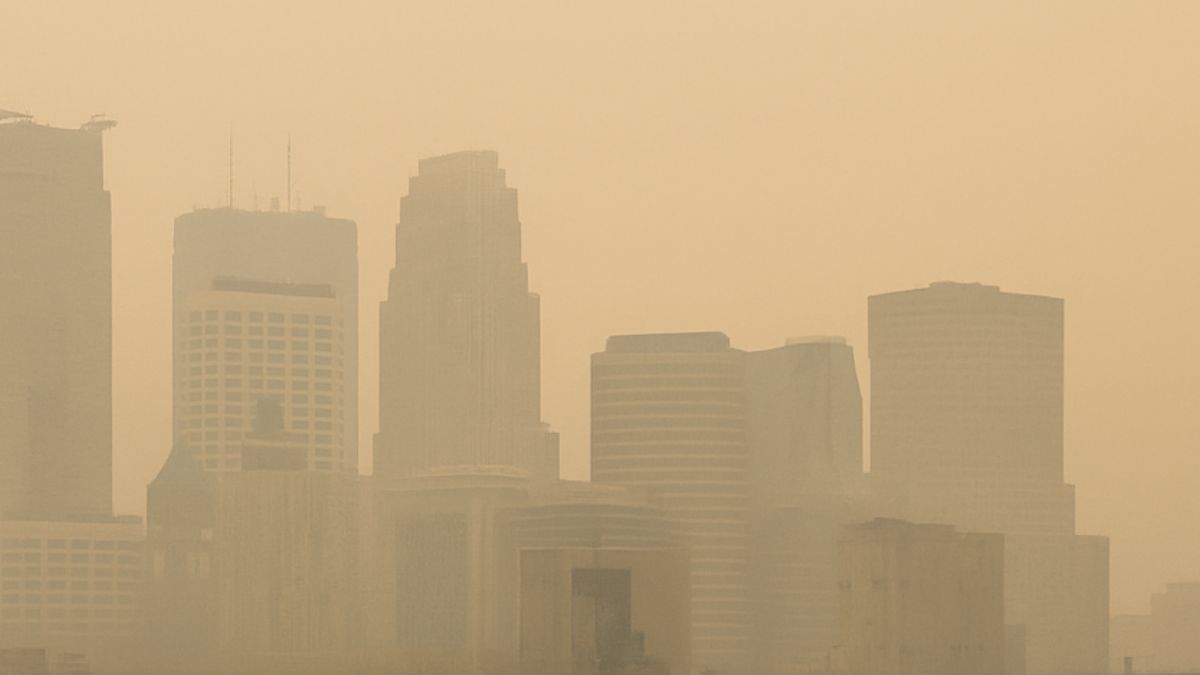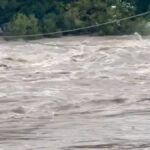Minneapolis: Millions of Americans across Minnesota, Wisconsin, and Michigan were urged to stay indoors on Sunday as thick wildfire smoke from Canada blanketed large parts of the Midwest. The air quality index (AQI) in the Twin Cities reached “unhealthy” levels early Sunday morning, with dense smoke expected to linger until noon.
Forecasts from KSTP’s First Alert system predicted Southwest winds will push the smoke north and east by 2 p.m., offering temporary relief. However, another plume is expected to return overnight, with air quality deteriorating again Monday across Minnesota and Wisconsin. The statewide air quality alert remains in effect until 9 a.m. Monday.
The National Weather Service warned, “Everyone should reduce or avoid prolonged or heavy exertion outdoors,” especially vulnerable groups such as children, older adults, and individuals with asthma or heart conditions. Monday is forecasted to be the hottest day of the week, with temperatures near 90°F and increasing humidity, potentially worsening health risks for those exposed.
Minnesota is under an air quality alert due to wildfire smoke until July 14. Limit outdoor activities and if possible, keep your windows closed.
Learn more about this alert here: https://t.co/sTUHPxZ1I6
Visit https://t.co/y5QAPMlvTf for the latest air quality conditions. pic.twitter.com/ytoRBwqEP5
— City of Minneapolis (@CityMinneapolis) July 12, 2025
Also Read: Minnesota Air Quality Alert: Canadian Wildfire Smoke Triggers Statewide Warning
Why is the air quality so bad in Minneapolis right now?
The culprit: more than 100 wildfires burning across Canada’s Manitoba province, over 20 of which were still out of control as of Sunday morning. These fires have already scorched 2.5 million acres, prompting a second state of emergency this year and displacing thousands.
As smoke drifted south, 22 million Americans across the Midwest found themselves under air quality alerts. In Minneapolis, the AQI surged to levels considered “very unhealthy” by early Sunday, before gradually improving in the afternoon as winds shifted.
“We write to you today on behalf of our constituents who have had to deal with suffocating Canadian wildfire smoke,” said a group of six Republican lawmakers from Minnesota and Wisconsin in a letter to Canada’s ambassador to the U.S., “Summer months are the best time of the year to spend time outdoors… but this wildfire smoke makes it difficult to do all those things.”
What is the official air quality forecast for Minneapolis this week?
- Sunday: Dense smoke until noon, AQI levels “unhealthy”; highs in the upper 80s. Southwest winds will improve air by afternoon.
- Monday: Hot and sunny with highs near 90°F; humidity increases. Another plume of smoke moves in overnight, keeping AQI at unhealthy levels.
- Tuesday: Sunny, humid, highs in low 90s. Scattered thunderstorms expected late.
- Wednesday–Thursday: Cooler, cloudy with rain. Some areas may see relief from the smoke by late Thursday.
Jonathan Yuhas of KSTP noted: “Smoke should be gone by end of Sunday from most of the state, while a new round of smoke could return Sunday night into Monday.”
What health risks are associated with wildfire smoke?
The main concern is PM 2.5, or fine particle pollution. These microscopic particles can enter the lungs and bloodstream, triggering heart attacks, asthma attacks, and serious respiratory issues.
“If you have asthma, follow your asthma action plan and keep quick-relief medicine nearby,” the NWS advised. “People with heart disease should seek medical attention if they experience unusual fatigue or shortness of breath.”
Residents are advised to:
- Keep windows closed, especially overnight
- Avoid outdoor activities, particularly strenuous ones
- Use air purifiers or wear N95 masks if venturing outdoors
What’s Canada doing to stop the wildfires?
Manitoba Premier Wab Kinew pushed back against U.S. criticism. “The letter was an attempt to trivialize and make hay out of a wildfire season where we’ve lost lives in our province,” he said.
While firefighting crews are deployed, hot, dry weather conditions in western Canada continue to fuel flames. Many fires are burning in remote areas, making suppression difficult and allowing smoke to travel thousands of miles south.







